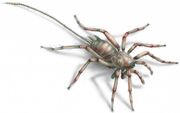
The whip-tailed spider (Chimerarachne lazardus), also known as the whip spider, the scorpion-tailed spider, and the scorpion spider, is a species of either Uraraneida or a separate clade closer to spiders, despite its name, that originally lived from Myanmar during the mid-Cretaceous, about 100 million years ago, as an extinct species, Chimerarachne yingi, and the genus itself was once extinct, but has since been brought back from extinction by SciiFii due to demand for more exotic de-extincted animals as pets. However, there are non-native feral breeding populations of whip-tailed spiders in Hawaii, mainland United States, Mexico, Japan, Great Britain, Australia, and New Zealand, most likely due to accidental releases. The size of the whip-tailed spider is quite small, being only 2.5 millimetres in body length, with the tail being about 3 millimetres in length. The whip-tailed spider resembles spiders in having two of its key defining features: spinnerets for spinning silk, and a modified male organ on the pedipalp for transferring sperm. At the same time, it retains a whip-like tail, rather like that of a whip scorpion and uraraneids. The abdomen of the whip-tailed spider is segmented, like that of a mesothele spider. However, unlike spiders, there are several short cylindrical segments at the back from which a long segmented tail (or flagellum) emerges. Whip-tailed spiders are carnivorous and prey on insects, spiders, and other invertebrates its own size or smaller, although it can sometimes hunt invertebrates slightly larger than itself. The whip-tailed spider's social lifestyle is very similar to jumping spiders, being primarily solitary except during the breeding seasons. The conservation status of the whip-tailed spiders living in the wild is Least Concern due to successful conservation efforts, the whip-tailed spider's wide range and its tolerance to many of the human activities.
